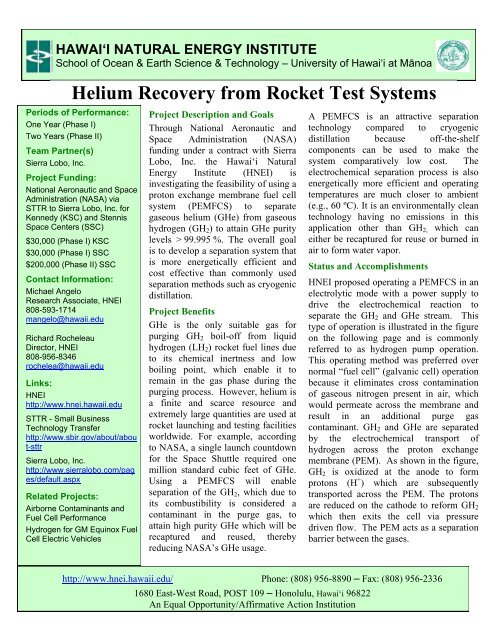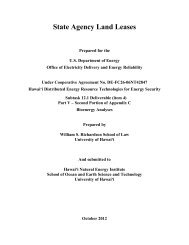Helium Recovery from Rocket Test Systems - Hawaii Natural Energy ...
Helium Recovery from Rocket Test Systems - Hawaii Natural Energy ...
Helium Recovery from Rocket Test Systems - Hawaii Natural Energy ...
Create successful ePaper yourself
Turn your PDF publications into a flip-book with our unique Google optimized e-Paper software.
HAWAI‘I NATURAL ENERGY INSTITUTE<br />
School of Ocean & Earth Science & Technology – University of Hawai‘i at Mānoa<br />
<strong>Helium</strong> <strong>Recovery</strong> <strong>from</strong> <strong>Rocket</strong> <strong>Test</strong> <strong>Systems</strong><br />
Periods of Performance:<br />
One Year (Phase I)<br />
Two Years (Phase II)<br />
Team Partner(s)<br />
Sierra Lobo, Inc.<br />
Project Funding:<br />
National Aeronautic and Space<br />
Administration (NASA) via<br />
STTR to Sierra Lobo, Inc. for<br />
Kennedy (KSC) and Stennis<br />
Space Centers (SSC)<br />
$30,000 (Phase I) KSC<br />
$30,000 (Phase I) SSC<br />
$200,000 (Phase II) SSC<br />
Contact Information:<br />
Michael Angelo<br />
Research Associate, HNEI<br />
808-593-1714<br />
mangelo@hawaii.edu<br />
Richard Rocheleau<br />
Director, HNEI<br />
808-956-8346<br />
rochelea@hawaii.edu<br />
Links:<br />
HNEI<br />
http://www.hnei.hawaii.edu<br />
STTR - Small Business<br />
Technology Transfer<br />
http://www.sbir.gov/about/abou<br />
t-sttr<br />
Sierra Lobo, Inc.<br />
http://www.sierralobo.com/pag<br />
es/default.aspx<br />
Related Projects:<br />
Airborne Contaminants and<br />
Fuel Cell Performance<br />
Hydrogen for GM Equinox Fuel<br />
Cell Electric Vehicles<br />
Project Description and Goals<br />
Through National Aeronautic and<br />
Space Administration (NASA)<br />
funding under a contract with Sierra<br />
Lobo, Inc. the Hawai‘i <strong>Natural</strong><br />
<strong>Energy</strong> Institute (HNEI) is<br />
investigating the feasibility of using a<br />
proton exchange membrane fuel cell<br />
system (PEMFCS) to separate<br />
gaseous helium (GHe) <strong>from</strong> gaseous<br />
hydrogen (GH2) to attain GHe purity<br />
levels > 99.995 %. The overall goal<br />
is to develop a separation system that<br />
is more energetically efficient and<br />
cost effective than commonly used<br />
separation methods such as cryogenic<br />
distillation.<br />
Project Benefits<br />
GHe is the only suitable gas for<br />
purging GH2 boil-off <strong>from</strong> liquid<br />
hydrogen (LH2) rocket fuel lines due<br />
to its chemical inertness and low<br />
boiling point, which enable it to<br />
remain in the gas phase during the<br />
purging process. However, helium is<br />
a finite and scarce resource and<br />
extremely large quantities are used at<br />
rocket launching and testing facilities<br />
worldwide. For example, according<br />
to NASA, a single launch countdown<br />
for the Space Shuttle required one<br />
million standard cubic feet of GHe.<br />
Using a PEMFCS will enable<br />
separation of the GH2, which due to<br />
its combustibility is considered a<br />
contaminant in the purge gas, to<br />
attain high purity GHe which will be<br />
recaptured and reused, thereby<br />
reducing NASA’s GHe usage.<br />
http://www.hnei.hawaii.edu/ Phone: (808) 956-8890 – Fax: (808) 956-2336<br />
1680 East-West Road, POST 109 – Honolulu, Hawai‘i 96822<br />
An Equal Opportunity/Affirmative Action Institution<br />
A PEMFCS is an attractive separation<br />
technology compared to cryogenic<br />
distillation because off-the-shelf<br />
components can be used to make the<br />
system comparatively low cost. The<br />
electrochemical separation process is also<br />
energetically more efficient and operating<br />
temperatures are much closer to ambient<br />
(e.g., 60 ºC). It is an environmentally clean<br />
technology having no emissions in this<br />
application other than GH2, which can<br />
either be recaptured for reuse or burned in<br />
air to form water vapor.<br />
Status and Accomplishments<br />
HNEI proposed operating a PEMFCS in an<br />
electrolytic mode with a power supply to<br />
drive the electrochemical reaction to<br />
separate the GH2 and GHe stream. This<br />
type of operation is illustrated in the figure<br />
on the following page and is commonly<br />
referred to as hydrogen pump operation.<br />
This operating method was preferred over<br />
normal “fuel cell” (galvanic cell) operation<br />
because it eliminates cross contamination<br />
of gaseous nitrogen present in air, which<br />
would permeate across the membrane and<br />
result in an additional purge gas<br />
contaminant. GH2 and GHe are separated<br />
by the electrochemical transport of<br />
hydrogen across the proton exchange<br />
membrane (PEM). As shown in the figure,<br />
GH2 is oxidized at the anode to form<br />
protons (H + ) which are subsequently<br />
transported across the PEM. The protons<br />
are reduced on the cathode to reform GH2<br />
which then exits the cell via pressure<br />
driven flow. The PEM acts as a separation<br />
barrier between the gases.
HNEI has demonstrated in two Phase I Small Business<br />
Technology Transfer (STTR) projects for Kennedy<br />
Space Center (KSC) and Stennis Space Center (SSC)<br />
that a laboratory-scale PEMFCS operated as a helium<br />
pump is capable of obtaining GHe streams with less<br />
than 50 parts per million (ppm) GH2 remaining <strong>from</strong><br />
inlet streams initially consisting of 1% GH2 (dry-gas<br />
basis). Additional work currently in progress will<br />
evaluate performance of a pilot-scale system that is 20<br />
times larger than the previous system with inlet streams<br />
of up to 10% GH2. Similar results have been obtained.<br />
A differential-reactor-based model was developed<br />
during the Phase I work to determine the mass transport<br />
coefficient of GH2 in the PEMFCS operating at its<br />
limiting current to approximate the flow conditions and<br />
system size required to attain < 50 ppm GH2 with up to<br />
10% GH2 at the inlet. The process was observed to be<br />
well modeled as diffusion limited at steady state with<br />
respect to the inlet GH2 concentration.<br />
An example of the ability of the model to predict the<br />
fraction of GH2 removed by the PEMFCS is given in<br />
the adjacent figure for the laboratory-scale system.<br />
Experimental data is represented by the squares and the<br />
fraction of hydrogen predicted to be removed <strong>from</strong> the<br />
model shown by the circles. The model fit well to the<br />
experimental data. It also predicted the flow conditions<br />
Hawai‘i <strong>Natural</strong> <strong>Energy</strong> Institute – <strong>Helium</strong> <strong>Recovery</strong> <strong>from</strong> <strong>Rocket</strong> <strong>Systems</strong><br />
for the pilot-scale system to more than 70 % of the<br />
expected performance.<br />
0.850<br />
0.0 0.2 0.4 0.6 0.8 1.0<br />
Future research activities include optimization of the<br />
operating conditions for the pilot-scale system to<br />
determine system durability at those conditions.<br />
Reports and Publications<br />
� M. Angelo, K. Bethune, and R. Rocheleau, “The<br />
Sizing and Evaluation of a PEMFCS to Separate<br />
Hydrogen and <strong>Helium</strong>,” In preparation for<br />
submission to Chem. Eng. Sci.<br />
� M. Angelo, K. Bethune, and R. Rocheleau,<br />
“Calculating H2 Mass Transport Coefficients at<br />
Different Operating Conditions using a Hydrogen<br />
Pump Configuration.” to be presented at the 222 nd<br />
Electrochemical Society, Honolulu, HI, USA, Oct. 7-<br />
12 th , 2012.<br />
� M. S. Angelo, M. S. Haberbusch, C. T. Nguyen, K. P.<br />
Bethune, and R. E. Rocheleau, “The Use of Proton<br />
Exchange Membrane Fuel Cell Technology to<br />
Recover Gaseous <strong>Helium</strong> <strong>from</strong> <strong>Rocket</strong> <strong>Test</strong>ing<br />
<strong>Systems</strong>,” ECS Trans. 41 (1), 1943 (2011).<br />
� Final Report entitled “Integration Study of an<br />
Innovative <strong>Helium</strong> <strong>Recovery</strong> System for the NASA<br />
Stennis Space Center,” (2011).<br />
� Final Report entitled “Integration Study of an<br />
Innovative <strong>Helium</strong> <strong>Recovery</strong> System for the NASA<br />
Kennedy Space Center,” (2010).<br />
REVISION DATE: 06/2012 HELIUM RECOVERY PROJECT<br />
Fraction of hydrogen removed<br />
1.050<br />
1.025<br />
1.000<br />
0.975<br />
0.950<br />
0.925<br />
0.900<br />
0.875<br />
1 % GH 2<br />
R.H. = 100 %<br />
Experimental data<br />
Model prediction (1 %)<br />
Fraction of Vol. flow used to determine<br />
mass transport coefficients




